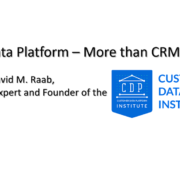The Role Data Plays in Customer Relationship Management
Image Source: Pixabay
The longevity of your business is dependent on your customer relationships. The depth of your customer relationships is connected to how well they’re managed. How well you work your customer relationships relies on the data you collect about them, like buying behaviors, values, needs, and lifestyle choices.
In addition to collecting quality customer data, organizing and effectively analyzing this data is vital to creating content, products, services, and anything else that resonates with your current and potential customers. Building an accurate customer journey and successfully using data in customer relationship management results in retaining customers and acquiring new ones to help drive more sales.
How is data used to manage customer relationships and navigate your customer’s journey with your business? Let’s first examine the difference between business analytics and data science and their respective roles in the effective use of data. We’ll then touch on the role data plays in creating your customer journey map and the best ways to use data to educate your CRM team.
Business Analytics vs. Data Science: What’s the Difference?
Business analytics and data science both play integral roles in the collection and usage of data. Knowing the difference between business analytics and data science makes building and maintaining customer relationships more productive. When you see the difference between data science and business analytics, you can make informed decisions about marketing techniques, sales funnels, software use, and other operational choices using your CRM team’s data.
What is business analytics?
Business analytics is the process of collecting data on overall processes, software, and other products and services, understanding it, and using it to make better business decisions. Data mining strategies and predictive analytics are among the tools and techniques used to execute the above actions.
Business analysts are adept in:
- Assessing and organizing raw data.
- Analyzing data about how to help a business improve.
- Forecasting and identifying patterns and sequences.
- Data visualization and conceptualizing business “big pictures.”
- Overall information optimization.
- Working with stakeholders to help them understand data.
Business analytics differs from data science in that it’s primarily used to establish how customer, software, system, tool, and technique data influence business growth. It transforms information into actionable steps that incite progress within a company and connection with current and potential customers.
What is data science?
Data science analyzes the collection process, the most streamlined and efficient ways to process data, and the most effective ways to communicate complex information to an analyst or company leader responsible for making critical business decisions. Data science takes advantage of emerging technologies like artificial intelligence, algorithms, and machine learning systems.
Data scientists are adept in:
- Evaluating specific questions and customer inquiries to develop data-driven strategies.
- Managing and analyzing critical information with the help of advanced technology.
- Detecting useful statistical patterns.
- Cleaning or “scrubbing” data.
- Making data easier to understand through efficient organization.
- Understanding how to leverage algorithms.
Data science differs from business analytics in that its primary focus is on collecting useful data and understanding different ways to best process and implement the collected data. Data science isn’t necessarily concerned with choosing the best ways to implement the lessons learned from data collection. Instead, it focuses on clearly communicating what the data means and listing implementation strategies, and leaving the decision up to business analysts and company leaders.
The Role Data Plays in Creating a Strong Customer Journey
According to Lucidspark, “A customer journey map is a diagram that illustrates how your customers interact with your company and engage with your products, website, and/or services.” It gives you a holistic view of a customer’s life-cycle with your business, from how they’re introduced to your brand, retained long enough to make a purchase, and nurtured into a long-term customer relationship.
The collection of customer data allows you to honestly know your audience and target them with personalized sales and marketing campaigns. It’s essential to understand how to collect data and interpret and implement it to create personal relationships with customers that result in loyalty and retention.
Data’s role in creating a robust customer journey map includes:
- Tracking why individual visitors don’t become customers.
- Identifying gaps in user experience.
- Understanding why people connect with your brand the way they do.
- Identifying similarities your long-term customers have.
- Identifying similarities new visitors have.
- Highlighting what messaging resonates most with your customers.
- Identifying marketing channels responsible for the most conversions.
- Pinpointing the best ways to communicate with your customers.
- Showing which digital platforms they make the most use of.
- Highlighting specific pain points, challenges, and problems common among your customers.
Your customer journey map gives specific details about your customers that you can use to construct an accurate representation of how they’d experience your brand. The more detailed the data, the more precise the customer journey. You can accurately map out:
- What problem or pain points do they have?
- Precisely what would bring them to researching a solution?
- How they’d choose your product as the solution?
- How they’d choose your brand to purchase that product?
- How do they make purchases in general?
- How they’d potentially purchase your product?
- How they’d receive your product and experience it?
- How they’d ultimately become a loyal customer?
The Best Ways to Use Data to Inform Your CRM Team
How can you use data to inform your customer relationship management team?
Using data effectively to inform your CRM team starts with functional CRM software. A CRM software can help seamlessly establish a relationship with customers by ensuring all the right information is collected, stored, and grouped correctly. The organizational structure a CRM software offers makes it easier for your CRM team to leverage collected data and shift strategies to accommodate customer needs and values.
CRM software is only as efficient as your team members are. Each team member plays an integral role in analytics and understands human behavior that drives data collection. Practical data analysis can inform your CRM team and help them with things like:
- Tailoring your social media content.
- Tracking spending habits and purchasing patterns.
- Catering website structure towards increased customer satisfaction.
- Boosting organic traffic.
- Identifying what data to collect and how to manage it.
- Establishing goals for your marketing efforts.
- Understanding the most efficient communication channels for your customers.
- Identifying what lifestyle behaviors could influence them completing a purchase with your business.
- Exploring paid advertising avenues.
- Segmenting your customer base.
- Constructing ads for digital platforms.
- Furthering your business’ online presence.
- Personalizing customer experiences with your brand through specific written content and visual media.
- Converting visitors to paying customers through sales techniques.
The ultimate goal for data collection and CRM software is customer acquisition and retention. Your CRM team can also use data to engage with customers consistently, streamline marketing funnels, and improve profitability with better products and services. They’re responsible for finding out what specific data is essential to collect, how it relates to moving your business forward, how you can turn the data into actionable strategies.
Other ways data collection informs your CRM team and helps shape overall business strategy include:
- Bettering customer resolution strategies and implementing simple systems for addressing customer issues.
- Choosing the most effective marketing media, brand colors, and overall business aesthetic.
- Generating personalized purchase recommendations and suggestions and automating how they’re sent to customers.
- Identifying opportunities for customer retention and gaps in acquisition techniques.
- Achieving a deeper understanding of the lifestyle your ideal customer lives.
- Improving your consumer database with a clean, simple, concise organizational structure.
You Can Maneuver Your Customer Journey Through Effective Use of Data in CRM
Data shows your CRM team how your customers are interacting with the brand and experiencing each stage of the buyer’s journey. Data can show you exactly who and what to focus on in building brand awareness. Tailor your messaging, aesthetics, events, engagement techniques, and marketing to your ideal customer’s behaviors.
By intentionally tracking essential customer data, you can implement the following potential solutions to maintain a healthy connection with each customer:
- Changing your brand colors to those that evoke emotions specific to how you want visitors to experience your product or service.
- Experimenting with different Call-to-action or CTA button colors and messaging.
- Shifting media and image choices to those most popular with loyal customers.
- Focusing solely on social media platforms most used by your target audience.
- Using marketing messaging to speak directly to their current experiences.
- Using the platforms your target audience gets their information from.
- Establishing a preferred communication method.
- Offering a variety of payment options that appreciate advanced technology.
Your CRM team can use data to make sales and marketing decisions that best align with company goals. Collecting and using customer relationship management data is the best practice for any business looking to define their customer’s journey with their brand clearly.






Leave a Reply
Want to join the discussion?Feel free to contribute!